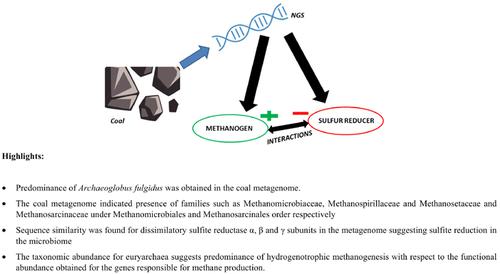当前位置:
X-MOL 学术
›
Curr. Genomics
›
论文详情
Our official English website, www.x-mol.net, welcomes your
feedback! (Note: you will need to create a separate account there.)
Unveiling the biodiversity of hyperthermophilic archaea in Jharia coal mines- Potential threat to methanogenesis?
Current Genomics ( IF 1.8 ) Pub Date : 2020-09-04 , DOI: 10.2174/1389202921999200605151722 Priyanka Jha 1 , Joginder Singh 1 , Ambarish S Vidyarthi 1 , Ram Prasad 1
Current Genomics ( IF 1.8 ) Pub Date : 2020-09-04 , DOI: 10.2174/1389202921999200605151722 Priyanka Jha 1 , Joginder Singh 1 , Ambarish S Vidyarthi 1 , Ram Prasad 1
Affiliation

|
Aim
To examine the biodiversity of archaeal sulfate reducers and methanogens present in the underground coal mines of Jharia using metagenomics and pyrosequencing. Objectives
1) Bioinformatical analysis of the metagenomic data related to a taxonomic analysis obtained from the coal to investigate complete archaeal taxonomic features of the coal bed methane (CBM) microbiome. 2) Bioinformatical analysis of the metagenomic data related to a functional analysis obtained from the coal to investigate functional features relating to taxonomic diversity of the CBM microbiome. 3) The functional attributes have been examined specifically for ORFs related to sulfite reduction and methanogenesis.The taxonomic and functional biodiversity related to euryarchaeota will help in a better understanding of the obstacles associated with methane production imposed by the sulfate reducers. Background
The microbial methanogenesis in the coal microbiome is a resultant of substrate utilization by primarily fermentative bacteria and methanogens. The present work reveals the biodiversity of archaeal sulfate reducers and methanogens present in the underground coal mines of Jharia using metagenomics and pyrosequencing. Methodology
Bioinformatical analysis for structural and functional attributes was accomplished using MG-RAST. The structural analysis was accomplished using RefSeq database, whereas the functional analysis was done via CoG database with a cut off value, a sequence percent identity, and sequence alignment length cut off of 1e-5, 60% and 45, respectively. Results
Attained communities revealed the dominance of hyperthermophilic archaea Pyrococcus furiosus along with Thermococcus kodakarensis in the coal metagenome.The obtained results also suggest the presence of dissimilatory sulfite reductase and formylmethanofuran dehydrogenase, formylmethanofuran: tetrahydromethanopterin formyltransferase involved in sulfite reduction and methanogenesis, respectively, in the microbiome. Conclusion
This report is the first attempt to showcase the existence of specific euryarchaeal diversity and their related functional attributes from Jharia coal mines through high throughput sequencing. The study helps in developing a better understanding of the presence of indigenous microbes (archaea) and their functions in the coal microbiome, which can be utilized further to resolve the energy crisis.
中文翻译:

揭示 Jharia 煤矿中超嗜热古菌的生物多样性——对产甲烷的潜在威胁?
目的使用宏基因组学和焦磷酸测序检查存在于 Jharia 地下煤矿中的古细菌硫酸盐还原剂和产甲烷菌的生物多样性。目标 1) 对与从煤中获得的分类分析相关的宏基因组数据进行生物信息分析,以研究煤层气 (CBM) 微生物组的完整古菌分类特征。2) 对与从煤中获得的功能分析相关的宏基因组数据进行生物信息学分析,以研究与 CBM 微生物组的分类多样性相关的功能特征。3) 专门针对与亚硫酸盐还原和产甲烷作用相关的 ORF 的功能属性进行了检查。与 euryarchaeota 相关的分类和功能生物多样性将有助于更好地了解与硫酸盐还原剂产生的甲烷相关的障碍。背景 煤微生物组中的微生物产甲烷是主要发酵细菌和产甲烷菌利用底物的结果。目前的工作使用宏基因组学和焦磷酸测序揭示了 Jharia 地下煤矿中存在的古细菌硫酸盐还原剂和产甲烷菌的生物多样性。方法 结构和功能属性的生物信息分析是使用 MG-RAST 完成的。结构分析是使用 RefSeq 数据库完成的,而功能分析是通过 CoG 数据库完成的,其截断值、序列百分比同一性和序列比对长度截断为 1e-5、60% 和 45,分别。结果 获得的群落揭示了煤宏基因组中超嗜热古细菌 Pyrococcus furiosus 和 Thermococcus kodakarensis 的优势。获得的结果还表明异化亚硫酸还原酶和甲酰呋喃脱氢酶的存在,甲酰呋喃:四氢甲蝶呤甲酰转移酶分别参与亚硫酸盐还原和产甲烷微生物组。结论 本报告首次尝试通过高通量测序展示 Jharia 煤矿中存在的特定古古菌多样性及其相关功能属性。该研究有助于更好地了解本土微生物(古细菌)的存在及其在煤炭微生物组中的功能,可进一步用于解决能源危机。
更新日期:2020-09-04
中文翻译:

揭示 Jharia 煤矿中超嗜热古菌的生物多样性——对产甲烷的潜在威胁?
目的使用宏基因组学和焦磷酸测序检查存在于 Jharia 地下煤矿中的古细菌硫酸盐还原剂和产甲烷菌的生物多样性。目标 1) 对与从煤中获得的分类分析相关的宏基因组数据进行生物信息分析,以研究煤层气 (CBM) 微生物组的完整古菌分类特征。2) 对与从煤中获得的功能分析相关的宏基因组数据进行生物信息学分析,以研究与 CBM 微生物组的分类多样性相关的功能特征。3) 专门针对与亚硫酸盐还原和产甲烷作用相关的 ORF 的功能属性进行了检查。与 euryarchaeota 相关的分类和功能生物多样性将有助于更好地了解与硫酸盐还原剂产生的甲烷相关的障碍。背景 煤微生物组中的微生物产甲烷是主要发酵细菌和产甲烷菌利用底物的结果。目前的工作使用宏基因组学和焦磷酸测序揭示了 Jharia 地下煤矿中存在的古细菌硫酸盐还原剂和产甲烷菌的生物多样性。方法 结构和功能属性的生物信息分析是使用 MG-RAST 完成的。结构分析是使用 RefSeq 数据库完成的,而功能分析是通过 CoG 数据库完成的,其截断值、序列百分比同一性和序列比对长度截断为 1e-5、60% 和 45,分别。结果 获得的群落揭示了煤宏基因组中超嗜热古细菌 Pyrococcus furiosus 和 Thermococcus kodakarensis 的优势。获得的结果还表明异化亚硫酸还原酶和甲酰呋喃脱氢酶的存在,甲酰呋喃:四氢甲蝶呤甲酰转移酶分别参与亚硫酸盐还原和产甲烷微生物组。结论 本报告首次尝试通过高通量测序展示 Jharia 煤矿中存在的特定古古菌多样性及其相关功能属性。该研究有助于更好地了解本土微生物(古细菌)的存在及其在煤炭微生物组中的功能,可进一步用于解决能源危机。











































 京公网安备 11010802027423号
京公网安备 11010802027423号